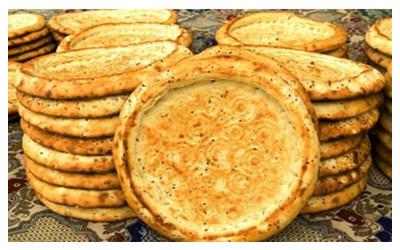Skype: neodalle-travel
Tel: +86 135 7447 2266
E-mail: sales@visitaroundchina.com

 Roast Nang is also Flat Bread. When you come to Kagshi in Xinjiang, whether it is in a city, countryside, a street or an alley, on a jubilation-wedding banquet, or in a camel team, you can find and taste a kind of round roasted bread, i.e. the traditional Uyghur staple food - Nang. It is everyday food of Uyghur, which is as important as steamed breads to the northerners and rice to the Southerners.
Roast Nang is also Flat Bread. When you come to Kagshi in Xinjiang, whether it is in a city, countryside, a street or an alley, on a jubilation-wedding banquet, or in a camel team, you can find and taste a kind of round roasted bread, i.e. the traditional Uyghur staple food - Nang. It is everyday food of Uyghur, which is as important as steamed breads to the northerners and rice to the Southerners.According to textual research, the word Nang came from Persian, which was popular in Arabian Peninsula, Turkey, center Asia various countries. Uyghur originally called it “Aimaik”, after Islam was spread to Xinjiang it was changed for “Nang”.
At present there are approximately 50 kinds of Nang, such as Nang with meat, oil, sesame, and so on. Different Nangs are for different occasions. Big Nangs such as "Aimaike" and "Shearman" are mainly for holidays and joyous occasions. Small portable Nangs such as "Tuachi" and "Katili" are food while people out touring or working.
Most nangs are baked with wheat-flour, corn or rice flour. They are named from their ingredients, shape and roast methods. Nang with lamb oil in it are called oil Nang, Nangs with ziyadan (seeds of a kind of grass), mutton cubes and spices such as pepper and onion fillings are meat Nang; Nangs with sesames and grape are called sesame Nang.
Nangs are baked in a stove called tonnir that has a big stomach and a little mouth that is made from sun-dried earth bricks. First heat the tonnir with firewood or charcoal. When the flame is to extinguish, put the dough on the inside walls of the tonnir. About 20 minutes later Nang is ready to eat.
Hot Nang is crisp and tasty. Uyghur often eat it with tea and mutton Kebab (roast mutton). In autumn, when grapes are ripe, they eat it with grapes, which are said to be more tasty and nutritious. Nang with only a little water in it do not go moldy easily and is easy to preserve. In harvest seasons, farmers usually carry with them several dozens of Nangs.
So do those out traveling or working in the Gobi desert. A few minutes after they bury nang under the hot sand, it will become crisp and delicious. A nang with a history of 1000 years has been evacuated which still did not go mold. It is said that when Chinese monk Xuanzang of Tang Dynasty went through Gobi desert he had nangs with him that fended him off hunger. According to record, as early as Han or Wei Dynasty, there were Nangs selling in the markets of Chang’an. It is also said that, after “the revolt of An Lushan of Shi Siming”, Xuanzong of Tang Dynasty ate Nang bought by the brother of Yang Guifei.
 Ask Questions ?
Ask Questions ?